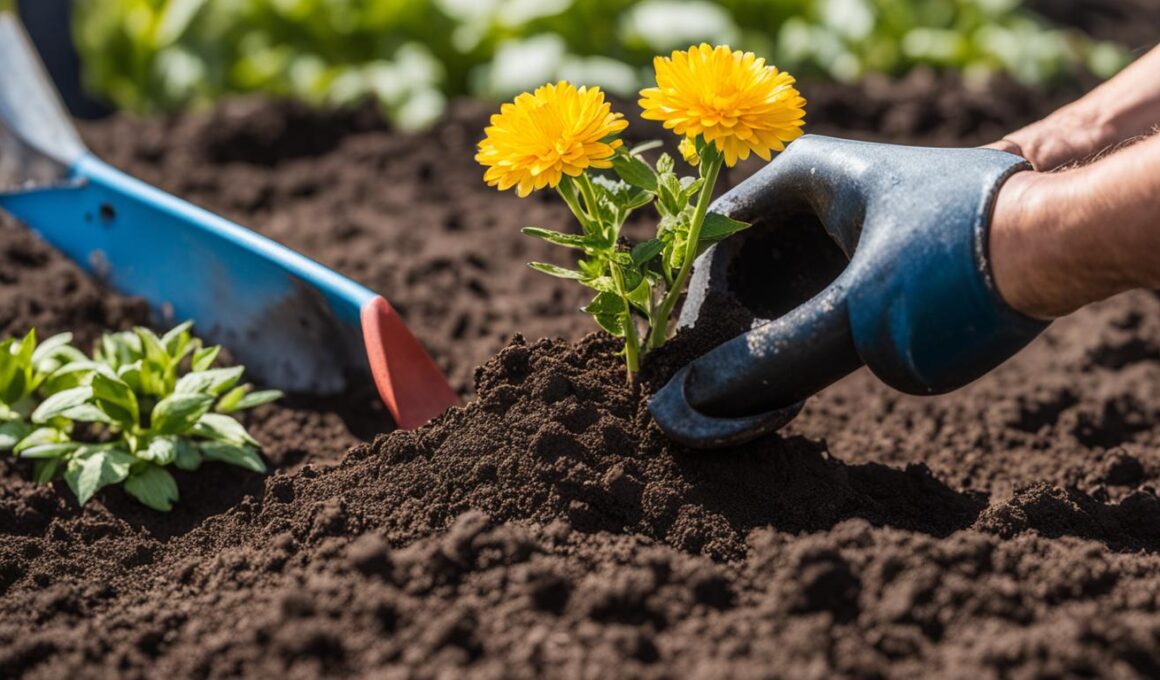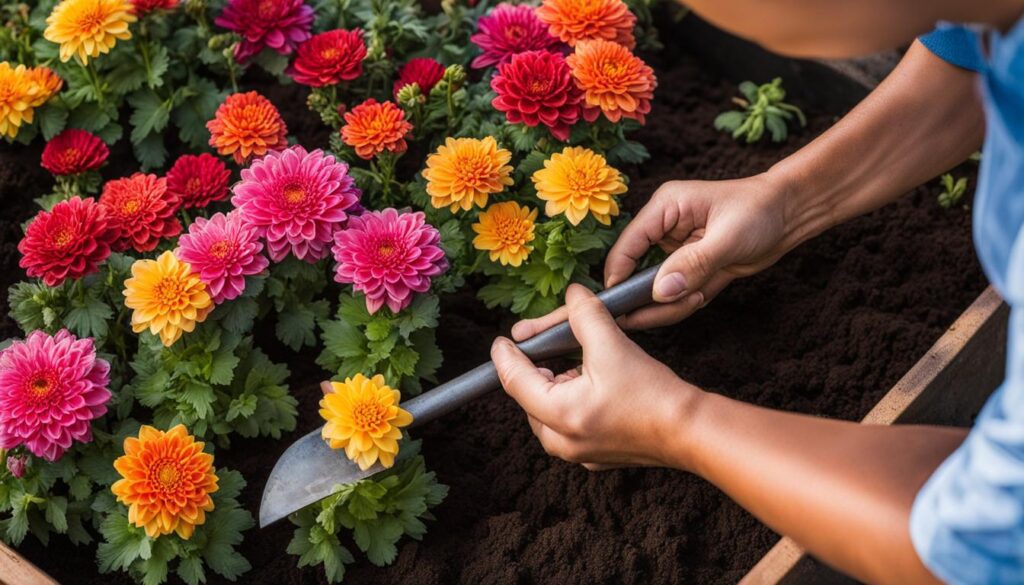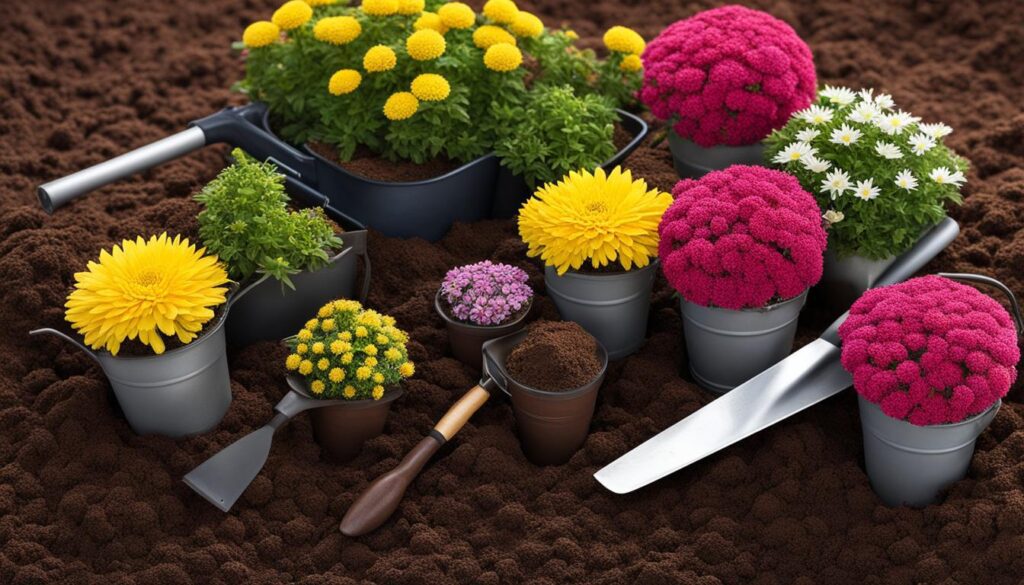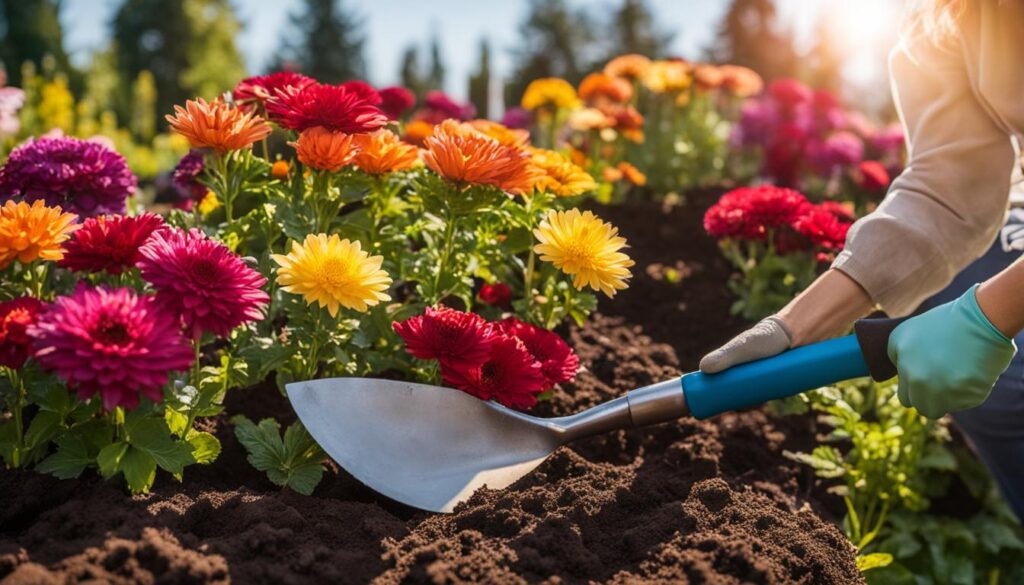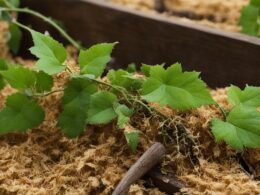Mums, also known as chrysanthemums, are a popular choice for adding color and interest to gardens in the autumn. Whether you have a green thumb or not, you may be wondering if you can plant mums directly in the ground. In this section, we will explore the feasibility of planting mums in your garden and provide you with some essential information to help you get started.
Mums come in various types, including garden mums, florist mums, and hardy mums. Garden mums are particularly suitable for planting in zones 4 to 9, as they are hardy and can withstand colder temperatures. Florist mums, on the other hand, are often treated as annuals in most parts of the country.
When planting mums, it is crucial to ensure they receive at least six hours of direct sunlight per day. This is a critical factor for their growth and overall health.
Post Summary
- Mums, or chrysanthemums, are a popular choice for adding color to gardens in the autumn.
- There are different types of mums, including garden mums, florist mums, and hardy mums.
- Garden mums are hardy and can be planted in zones 4 to 9.
- Florist mums are often treated as annuals.
- Mums require at least six hours of direct sunlight per day.
Are Mums Annuals or Perennials?
When it comes to mums, also known as chrysanthemums, the question of whether they are annuals or perennials is a common one. Technically, mums are perennials, meaning they have the potential to return year after year. However, their ability to survive the winter and come back in subsequent seasons depends on several factors.
If you plant mums in the fall, they may not have enough time to establish a strong root system before the winter frost arrives. As a result, many gardeners choose to treat mums as annuals and purchase new plants each year. This ensures that they have fresh, healthy plants that are more likely to thrive.
“Technically, mums are perennials… However, many gardeners choose to treat mums as annuals and purchase new plants each year.”
Whether you decide to treat mums as perennials or annuals, they can still provide beautiful, vibrant colors to your garden or containers in the fall. It ultimately comes down to personal preference and the specific growing conditions in your area. If you have a longer growing season and can provide the necessary care for mums to overwinter successfully, they can be enjoyed as perennials.
Pros and Cons of Treating Mums as Annuals
| Pros | Cons |
|---|---|
| Ability to choose fresh, healthy plants each year | Requires purchasing new plants annually |
| Ensures vibrant, full blooms | May not have as many color options as overwintered plants |
| Easier to control pests and diseases | Mums may not have a chance to establish a strong root system |
Ultimately, the decision to treat mums as annuals or perennials is up to you. Consider the specific conditions in your garden, the time and effort you are willing to invest, and your personal preferences. Whichever option you choose, mums can add a touch of beauty and color to your outdoor space in the autumn season.
Where Can I Buy Mums?
Mums are widely available in the fall, making it easy to find them for your garden or outdoor space. Here are some places where you can buy mums:
- Supermarkets: Many supermarkets carry potted mums in the floral section during the autumn season. They offer a convenient and affordable option for purchasing mums.
- Big-Box Retailers: Stores like Home Depot, Lowe’s, and Walmart often stock a variety of mums, including different colors and sizes. You can find them in the garden center or outdoor plant section.
- Nurseries: Local nurseries and garden centers are great places to find a wide selection of mums. They usually have knowledgeable staff who can provide guidance on choosing the right type of mums for your garden.
- Online Nurseries and Retailers: If you’re looking for unique varieties of mums or want to have them shipped to your doorstep, online nurseries and retailers are a good option. They offer a wide range of choices and the convenience of shopping from home.
Regardless of where you buy mums, it’s important to choose healthy plants with vibrant foliage and no signs of pests or disease. Look for mums with buds that are just starting to open, as this indicates the plant will have a longer blooming period.
“Mums are a popular fall plant that can be found in many places, from supermarkets to online nurseries. Take your time to select healthy plants with promising buds for a longer blooming season.” – Gardening Expert
Buying mums from different sources can also give you the opportunity to compare prices and find the best deals. Whether you prefer the convenience of a supermarket or the expertise of a local nursery, you’re sure to find mums that will add a burst of color to your fall garden.
| Retailer | Availability | Advantages |
|---|---|---|
| Supermarkets | Fall season | Convenient and affordable |
| Big-Box Retailers | Fall season | Wide variety, including different colors and sizes |
| Nurseries | Fall season | Knowledgeable staff, wide selection |
| Online Nurseries and Retailers | Year-round | Convenience, unique varieties |
So, whether you prefer to shop in person or online, buying mums is easy and accessible. Enjoy the process of selecting the perfect mums for your garden and watch them bloom into beautiful fall flowers.
When Should I Plant Mums?
Planting mums at the right time is crucial for their survival and long-term growth. While fall is typically associated with mums, planting them in the spring is recommended for the best results. By planting mums in the spring, you give them ample time to establish a strong root system before the winter arrives.
When you buy mums, look for plants in tight bud rather than full bloom. This increases their chances of survival when planting them in the spring. Mums purchased in the fall may reemerge the following spring, but it is not guaranteed.
If you decide to plant mums in the fall, be aware that their chances of surviving the winter and returning in subsequent seasons may be lower. However, if you live in a climate where winters are mild and the ground doesn’t freeze, fall planting might still be a viable option.
Best Time to Plant Mums:
“For the best chance of success, plant mums in the spring, giving them plenty of time to establish before winter sets in.”
| Planting Time | Benefits | Considerations |
|---|---|---|
| Spring | Allows mums to establish a strong root system before winter | Mums purchased in fall may not survive the winter |
| Fall | Mums may reemerge in the following spring | Chances of survival and returning in subsequent seasons are lower |
By planting mums in the spring, you give them the best possible chance of thriving in your garden. Remember to choose plants in tight bud and follow proper planting and care techniques to ensure beautiful blooms year after year.
How Do I Plant Mums?
Planting mums is a straightforward process that can be done in a few simple steps. Here’s a step-by-step guide to help you successfully plant mums in your garden or containers:
- Choose a suitable location: Mums thrive in full sun, so select an area that receives at least six hours of direct sunlight per day.
- Prepare the soil: Ensure the soil is well-draining by adding organic matter or compost to improve its fertility and drainage.
- Dig a hole: Dig a hole slightly larger than the pot the mum plant comes in.
- Plant the mum: Place the plant in the hole so that the entire root ball is level with or slightly above the ground.
- Backfill the hole: Fill the hole with soil, gently firming it around the plant to eliminate air pockets.
- Water thoroughly: After planting, water the mum thoroughly to help settle the soil and ensure proper hydration.
- Maintenance: Water the mum regularly, especially during hot and dry spells. Consider pinching off the tips of the plants in late spring or early summer to encourage branching and prevent flopping.
If you prefer, you can also plant mums in decorative pots or containers for seasonal enjoyment. Ensure the container has adequate drainage holes and use well-draining potting soil for optimal growth.
“Planting mums in the right conditions, providing adequate sunlight, well-draining soil, and regular watering can result in beautiful blooms that last well into the autumn season.”
Remember to water your mums regularly, especially during dry periods, and provide them with the necessary care and maintenance to enjoy their vibrant blooms for an extended period.
| Planting Mums | Growing Conditions | Care Tips |
|---|---|---|
| Sunlight | Full sun, at least 6 hours of direct sunlight per day | Regular watering, especially during hot and dry spells |
| Soil | Well-draining soil, enriched with organic matter or compost | Consider pinching off tips to encourage branching |
| Potting | Use well-draining potting soil | Water thoroughly after planting and provide regular watering |
How Do I Care for Mums?
Proper care is essential for keeping your mums healthy and vibrant. Here are some tips to help you care for your mums and ensure they thrive:
- Watering: Mums require regular watering, especially during dry spells. Be sure to water the plants deeply, allowing the soil to become thoroughly soaked. However, avoid overwatering, as mums do not tolerate soggy soil.
- Fertilizing: If you planted your mums in the fall, they generally do not require additional fertilization. However, if greenery appears in the spring, you can apply a slow-release granular fertilizer to promote healthy growth.
- Pinching: Pinching off the tips of your mums in late spring or early summer can encourage branching and prevent the plants from flopping over. This will result in a bushier, more compact plant with more blooms.
- Protection: Mums are typically not attractive to deer and other animals, making them a great choice for gardens. However, if you notice pests or diseases on your mums, take appropriate measures to protect your plants.
“Regular watering, proper fertilization, and strategic pinching can help ensure your mums stay healthy and produce abundant blooms.”
By following these care tips, you can enjoy beautiful, vibrant mums throughout the autumn season and beyond. Remember to provide adequate sunlight, well-draining soil, and regular care to keep your mums looking their best.
Can You Plant Mums In Different Soil Types?
Mums, also known as chrysanthemums, can thrive in a variety of soil types if the conditions are right. While they prefer well-draining soil, they can tolerate different soil textures, including sandy, loamy, and clay soils. However, they may struggle in extremely heavy or compacted soil, so it is important to ensure good drainage to prevent waterlogging.
When planting mums in different soil types, it is beneficial to amend the soil with organic matter or compost to improve its fertility and drainage. This can be done by incorporating the organic material into the top few inches of soil before planting the mums. Additionally, adding a layer of mulch around the base of the plants helps conserve moisture and regulate soil temperature.
Soil pH and Mums
The pH level of the soil can also affect the growth and health of mums. They prefer slightly acidic to neutral soil, with a pH range of 6.0 to 7.0. To determine the pH of your soil, you can use a soil testing kit or send a sample to a soil testing laboratory. If the pH is too low or too high, you can adjust it by adding amendments such as lime to raise the pH or sulfur to lower it.
| Soil Type | Characteristics |
|---|---|
| Sandy | Well-draining, low fertility |
| Loamy | Well-draining, moderate fertility |
| Clay | Heavy, compacted, good water retention |
Regardless of the soil type, it is important to water mums regularly, especially during hot, dry weather. This helps keep the soil evenly moist and prevents stress and wilting. Monitor the soil moisture levels and adjust the watering frequency accordingly to ensure the mums receive adequate hydration.
How to Plant Mums in Containers
Planting mums in containers is a great way to add color and interest to your patio or garden. Follow these steps to successfully grow mums in pots:
- Choose a pot that is larger than the root ball of the plant. This will allow the roots to spread out and establish properly.
- Fill the container with well-draining potting soil. Mums prefer soil that is slightly acidic and rich in organic matter.
- Make sure there is enough space for the plant to grow. Mums can become quite bushy, so leave enough room for the foliage to spread out.
- Water the mums thoroughly after planting. This will help settle the soil and ensure that the roots make good contact. Provide regular watering throughout the growing season, keeping the soil evenly moist but not waterlogged.
Remember to fertilize your container-grown mums every few weeks with a balanced, water-soluble fertilizer. This will provide the necessary nutrients for healthy growth and abundant blooms.
“Planting mums in containers can be a fun and rewarding gardening project. The versatility of container gardening allows you to easily move and rearrange your mums to create different displays. Plus, the vibrant colors of mums can brighten up any outdoor space.”
Tips for Successful Container Gardening with Mums
Here are some additional tips to help you successfully grow mums in containers:
- Choose a container with good drainage holes to prevent waterlogging and root rot.
- Place your containers in a location that receives at least six hours of direct sunlight per day. Mums thrive in full sun.
- Keep an eye on the moisture levels of the soil. Mums prefer evenly moist soil but can suffer from root rot if overwatered.
- Deadhead your mums regularly to promote continuous blooming and prevent the plants from diverting energy to seed production.
- Protect your container-grown mums from extreme weather conditions, such as strong winds and frost. Move them to a sheltered location if necessary.
| Variety | Bloom Color | Bloom Size | Height | Spacing |
|---|---|---|---|---|
| Autumn Glow | Yellow | Medium | 18-24 inches | 12-18 inches |
| Fireworks | Red | Large | 20-24 inches | 18-24 inches |
| Lavender Mist | Lavender | Small | 12-16 inches | 12-18 inches |
| Sunshine Yellow | Yellow | Small | 14-18 inches | 12-16 inches |
Whether you choose to plant mums in containers or in the ground, they are sure to add beauty and vibrancy to your garden. With the right care and attention, your mums will thrive and provide a stunning display of color throughout the autumn season.
How to Plant Mums in Flowerbeds
Planting mums in flowerbeds can add a burst of color and vibrancy to your garden. To ensure the successful growth of your mums, follow these steps:
- Clean the planting area: Remove any debris, weeds, or old plants from the flowerbed to create a clean and clear space for the mums.
- Prepare the soil: Tilling the soil and incorporating flowerbed garden soil can help improve its quality and drainage. This will provide a better environment for the mums to establish their roots.
- Choose the right location: Select a spot in the flowerbed that receives at least six hours of direct sunlight daily. Mums thrive in full sun and require adequate sunlight for healthy growth and abundant blooms.
- Dig the hole: Dig a hole that is slightly larger than the root ball of the mum plant. This will allow the roots to spread out and establish themselves easily.
- Plant the mum: Place the mum plant in the hole and backfill it with the garden soil. Ensure that the entire root ball is covered, and the mum is planted at the same level as the surrounding ground.
- Water thoroughly: After planting, water the mums thoroughly to settle the soil and provide hydration to the newly planted mum. Water regularly, especially during dry spells, to keep the soil moist.
- Mulch the flowerbed: Apply a layer of organic mulch around the mums to help retain moisture and suppress weed growth. This will provide additional insulation and protection for the plants.
By following these steps, you can plant mums in flowerbeds and create a stunning display of colorful blooms. With proper care and attention, your mums will thrive and beautify your garden throughout the autumn season.
Garden Mum Care Tips
Proper care is essential to ensure that your garden mums thrive and produce abundant blooms. Here are some valuable tips to help you care for your garden mums:
Watering:
Mums have shallow root systems, so regular watering is crucial, especially during hot weather. Aim to keep the soil evenly moist, but not waterlogged. Water deeply and thoroughly, avoiding shallow, frequent watering, as it can lead to weak root growth.
Mulching:
Applying a layer of organic mulch around the base of your garden mums helps retain moisture in the soil, prevents weed growth, and regulates soil temperature. Use a 2-3 inch layer of mulch, such as straw or shredded bark, making sure to keep it a few inches away from the stems to prevent rot.
Pruning:
To encourage branching and ensure a fuller plant with more blooms, prune your mums in early spring. Cut back the stems to around 4-6 inches above ground level, leaving a few healthy buds on each stem. This will promote new growth and result in a bushier, more compact plant.
Fertilizing:
For optimal growth and abundant flowers, fertilize your garden mums in spring and fall. Use a balanced slow-release fertilizer or a water-soluble fertilizer diluted according to the package instructions. Apply the fertilizer around the base of the plants, taking care not to over-fertilize, as this can lead to leggy growth and fewer blooms.
By following these care tips for your garden mums, you can enjoy their vibrant colors and beautiful blooms throughout the autumn season. Remember to provide regular watering, mulch to retain moisture, prune for bushier growth, and fertilize for healthy plants.
Conclusion
Mums are a versatile and popular choice for adding vibrant colors to gardens and containers in the fall. Whether you plant them as perennials or treat them as annuals, mums can bring beauty to your outdoor spaces. By providing the right conditions, such as adequate sunlight, well-draining soil, and regular watering, you can enjoy their beautiful blooms that last well into the autumn season.
With proper care, mums can be planted in the ground or in containers, adding a burst of color to your garden or patio. They are relatively low-maintenance plants and can thrive with minimal effort. Remember to prune them in early spring to encourage fuller growth and provide support if needed to prevent flopping.
So, whether you choose to buy mums from local retailers or online nurseries, remember to consider the specific needs of the plant. Planting mums in the right conditions and providing them with the care they need will reward you with stunning displays of colorful blooms that will brighten up your autumn landscape.
Are Mums and Monstera Adansonii both suitable for planting in the ground?
Yes, both mums and Monstera adansonii can be planted in the ground. However, it is important to consider the specific needs of each plant. For example, Monstera adansonii may become root bound if not given enough space to grow, so be mindful of planting conditions.
FAQ
Can you plant mums in the ground?
Yes, mums can be planted in the ground. They are available in two main types: garden mums and florist mums. Garden mums are hardy and can be planted in zones 4 to 9. Florist mums are typically treated as annuals in most parts of the country.
Are mums annuals or perennials?
Technically, mums are perennials. However, if you plant them in the fall, they may not establish a good root system and survive the winter. Many people choose to treat mums as annuals and buy new ones each year.
Where can I buy mums?
Mums are widely available in the fall at supermarkets, big-box retailers, and nurseries. For a wider selection and unique varieties, online nurseries and retailers are a good option. You can also order mums in the fall and have them shipped in the spring for earlier planting and better chances of survival.
When should I plant mums?
For mums to have the best chance of returning in subsequent seasons, it is recommended to plant them in the spring. Fall planting can sometimes result in mums reemerging the following spring, but it is not guaranteed. Buying plants in tight bud rather than full bloom may improve their chances of survival.
How do I plant mums?
To plant mums, dig a hole slightly larger than the pot and place the plant in the hole so that the entire root ball is at the same level as the ground. Backfill the hole with soil, water well, and continue to water during hot, dry spells. Alternatively, you can plant mums in decorative pots for seasonal enjoyment.
How do I care for mums?
Mums are generally low-maintenance plants. They don’t require feeding if planted in the fall, but if greenery appears in the spring, a slow-release granular fertilizer can be applied. Pinching off the tips of the plants in late spring or early summer encourages branching and prevents flopping. Mums are typically not attractive to deer and other animals.
Can you plant mums in different soil types?
Mums prefer well-draining soil, so it is important to ensure that the soil is not overly compacted or waterlogged. Adding organic material or compost to the soil can improve its drainage and fertility. Regardless of the soil type, mums require watering, especially during periods of hot, dry weather.
How to plant mums in containers?
When planting mums in containers, choose a pot that is larger than the root ball of the plant. Fill the container with well-draining potting soil, and make sure there is enough space for the plant to grow. Water the mums thoroughly after planting and provide regular watering during the growing season. Mulching the container helps retain moisture.
How to plant mums in flowerbeds?
To plant mums in flowerbeds, prepare the planting area by removing debris and tilling the soil. Incorporate flowerbed garden soil to improve the soil quality. Dig a hole that is larger than the root ball of the mum plant and place the plant in the hole. Backfill with garden soil and water thoroughly. Mulching around the mums helps retain moisture and protect the plants.
What are some garden mum care tips?
Regular watering is necessary for mums, especially during hot weather, as they have shallow root systems. Applying a layer of organic mulch around the plants helps retain moisture and suppress weed growth. Pruning mums in early spring encourages branching and ensures a fuller plant with more blooms. Fertilizing mums in spring and fall promotes healthy growth and abundant flowers.





